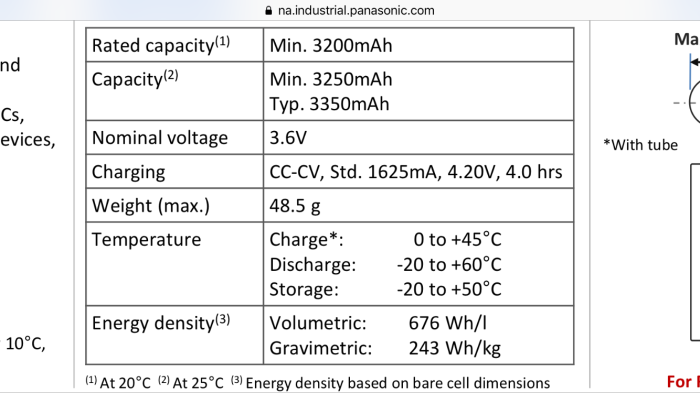
A label inside the Bolt EV battery pack shows an overall pack energy capacity rating of 57 kWh.
Conflicting values for the energy capacity of the Chevrolet Bolt EV battery pack coming from LG and GM are actually consistent and are just reporting different ways of measuring energy storage capacity, according to GM spokesman Christopher Bonelli.
Recent photos taken during a Bolt EV battery pack disassembly at a GM dealer and in a series of pack disassembly videos on YouTube show that LG labels inside the pack rate it as holding 57 kilowatt-hours (kWh). GM has marketed the Bolt as having 60 kWh of energy storage and have also used that value in documents filed with the U.S. Environmental Protection Agency.
“The 57 kWh number on the battery label is the “rated energy”, a regulatory requirement that represents the absolute minimum energy content (under worse case scenarios), not the energy target. Accounting for typical statistical variation, LGE [LG Electronics] has been delivering the targeted 60 kWh of nominal pack energy”, Bonelli said.
Indeed, according to multiple owners, the energy use display on the center infotainment screen typically shows values implying that the full battery pack is often capable of providing 58 to 59 kWh of usable energy. GM’s nominal rating of 60 kWh does not represent the energy usable by the driver since, according to Bonelli, “we do allow for a small buffer in the battery to ensure battery life and durability”.

Professor John Kelly of Weber State University reads the energy capacity labels from the two different battery module sizes used in the Bolt EV pack. In total, there are 8 modules declared as 5.94 kWh and 2 modules declared as 4.75 kWh. The mixed pack sizes are used in the stacked portion of the pack which is installed under the rear seats. The full video is available on YouTube.
The “rated” and “nominal” energy values differ because they are measured under different conditions. There is no industry standard for what those conditions should be so battery manufacturers normally document the conditions under which their own published measurements are made.

This screen capture from the specification of a Panasonic 18650 cylindrical cell shows that the “rated” capacity is taken at 20C but the “nominal” capacity is taken at a warmer 25C.
As an example, a Panasonic battery specification footnote (shown above) states that the “rated” value of the cell was measured at 20C (68F). The higher “nominal” energy value was measured at the warmer temperature of 25C (77F). The rated and nominal measurements could also, in some cases, be taken at different current discharge rates and ending voltages.
It is known that lithium-ion cells can, in general, hold and release more energy at warmer temperatures but they also can age or lose capacity faster at warmer temperatures (especially when nearly full). GM has previously said that the nickel-rich composition of the Bolt EV cell cathodes allows them to operate at slightly warmer temperatures than usual without excessive aging.
In the case of the Panasonic cell, the typical (nominal) energy capacity is about 5 percent higher than the “rated” capacity which is similar to the difference between the rated and nominal capacities reported by LG and GM for the Bolt EV pack.
LG and GM have not released detailed battery cell specifications so the details of how the rated and nominal measurements were taken with the Bolt EV cells is not known.
As can be seen, determining and reporting the exact energy capacity of a battery is complex which makes close comparisons among the packs in different cars difficult.
See: Jaguar and Chevy have LG in common
Categories: Battery
Interesting clarification Jeff. Thanks for seeking out and getting a response from GM. I still consider 60kWh a typical usable capacity with something higher, maybe 63kWh, as total capacity assuming a 0.3C discharge rate.
LikeLiked by 1 person
I have seen people report center screen data that suggests 58-59 kWh usable on a full charge. I can’t recall if I ever saw data suggesting 60 kWh usable. I’ve been assuming they need at least 5% buffer which suggests a typical 3-5 kWh buffer. I still think that makes sense but I don’t have a lot of confidence in that guess.
LikeLike
Here’s an example, possibly an outlier, of someone who has repeatedly tested their car to have 61-62kWh usable capacity. http://www.chevybolt.org/forum/82-charging-batteries/21769-depletion-battery-2.html#/topics/21769?page=2
LikeLiked by 1 person
Interesting.
LikeLike
There are very few online examples of people driving their car to zero power and posting the kWh used data. I’ve seen a few examples of folks getting low (“reduced power mode”), not actually to the very end, but showing 57-58kWh.
LikeLike
Reblogged this on Swiss Coaching Partners.
LikeLike
Am glad you reached out to GM and have helped clarify this.
LikeLike
I have read your article and information, I purchased batteries for experimenting the battery does not give much information other than it is labeled Energy and on the negative end stamped gm.I have so far been impressed but it claims 10000mah? This Energy battery holds power very well and I have discharged them 0 no problem charging to recover 4.2 Vdc.My question? Do you know or have information on this specific battery? I will appreciate your time and any information you wish to share your article is very informative
. Thank you in advance.
LikeLike